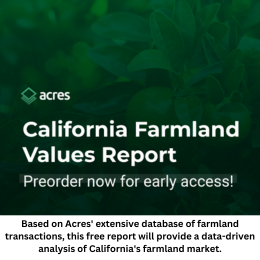May 17, 2018
By Michael Helmstetter, CEO and co-founder of TechAccel, as appeared in GAI Gazette, June 2018, Volume 5, Issue 2
The 2015 agtech investment bubble was a master class in the difference between ‘big money’ and ‘smart money’.
Big money flows indiscriminately into the ‘Next Big Thing’. While it might fund a lot of startups, it can easily pressure them into an unsustainable business model or the wrong market. If enough big money hits a sector – the way it hit agtech in 2015 – it can infuse a frenetic energy into a niche ecosystem. But when the bubble bursts, consumers come away skeptical of the value of speedy innovations, making the next cycle that much harder to get off the ground.
On the other hand, smart money doesn’t just fund startups; it shepherds useful products to exit. Smart money insists on a deep understanding of the market and how a product addresses the needs of the customer. By supporting companies and products that provide clear value, smart money offers support to an entire ecosystem through sustainable growth, propelling future innovation.
From gene editing to artificial intelligence, agtech is one of technology’s fastest-moving sectors. With so much to be gained, it is crucial to understand how big money can hamper innovation, as witnessed in the aftermath of 2015’s agtech investment bubble. Instead, the sector needs smart money and here is why.
2015, Re-examined
As perceptively noted by The Breakthrough Institute, “Just because it is mechanically possible to put different amounts of fertilizer or water in each part of a field does not mean that we know the best amount to put there.” In the end, this describes many of the products and services that didn’t sell.
In 2015, big money destabilized agtech through an influx of indiscriminate cash that prompted many companies to take their eye off the customer. Instead of investing in things that actual farmers would use, there was energy channeled into speculative innovations based on what worked in tech. This resulted in a proliferation of cross-over technology like drones, remote sensors, and other precision agtech that teemed with promise but much of which lacked in real-world application.
Part of this error can be attributed to companies misunderstanding the complexity of the ag market space. It is influenced by hundreds of factors, from weather patterns to microorganisms, and consists of a diverse ag infrastructure made up of farmers, suppliers, co-ops, commodity traders, labor, transport systems, processors, banks, lenders, and numerous other go-betweens. Without an on-the-ground understanding of the industry, companies pitched products to the wrong audience or at the wrong spot in the value chain.
In 2015, the idea of big rewards attracted funds from Silicon Valley venture capitalists, but not everyone was ready, willing, or able to sustain an investment that requires years (and growing seasons) of patience.
Smart Money Cuts the Hype
With trends like soil sensors and drones hitting new lows on the agtech hype curve, now is a ripe time for smart money to refine the agtech industry, bringing smart ideas to fruition with these three rules for startups and investors:
Go back to basics.
Before sourcing out funding, it is critical that as a company, you identify exactly what needs your product addresses. If you are still hazy on an exact target audience and pain point, you need to talk to the people in the chain who have the need you are solving. You need to understand their world in a deep and personal way. Walk in the fields, work on the machinery, get up early to tend the animals with them. Understand the multidimensional pain points that are on their minds regularly before you propose options to address those issues.
From here, study your market. Know where your product will fit in the value chain before you start out, and then test your knowledge. Check multiple points in the ecosystem and be willing to learn or adjust.
Be patient.
Think in terms of growing seasons, not software update cycles. These products, markets, and players have long-term cycles for planning, investing, and acting. That may mean learning to look beyond short-term incentives.
Trends like massive chemical application in farm fields and widespread use of antibiotics in farm animals may have created short-term production cost advantages, but with significant long-term fallout: environmental damage, antibiotic-resistant bacteria, lawsuits, and consumer backlash. The ability to take the long view isn’t just essential to success in the ag space; it’s essential to developing any truly disruptive innovation.
Be ready to be humbled.
Even if your solution works perfectly in the first field trial, be aware that it may fail in the second. Agriculture is notoriously difficult to control, across both time and geographies. In fact, replication of a controlled environment may ultimately be a futile goal.
Instead, take each failure as an opportunity to learn and iterate. Look for common issues across markets. This can increase the costs and time needed, but if you’ve taken the time to learn your customers well, it also gives you more ‘swim lanes’ to work in. Over the long run, you’ll gain more information more quickly.
Building Ag Tech Innovation
When smart money drives investment in agtech, the benefits won’t be confined to just the industry. With an open exchange of information derived from adoption in ag, new best practices will emerge. This can help build sustainability into each new cycle of innovation.
Smart money doesn’t just sustain industry growth, it sustains our planet.
Impacts of ‘Big Money’
Billion-dollar agriculture startups have attracted significant venture capital, which, of course, lures even more from investors driven by a fear of missing out. Here are the top-seated ag unicorns worth watching to see how staying power and sustainability plays out:
- Indigo Agriculture, a promising technology to treat seeds with microbes to produce crops that are tolerant to heat and stress and produce greater yields, claimed the title of 2017’s top-funded agriculture unicorn. Based in Boston, this agtech startup closed a $203 million Series D round in December 2017 and generated a $1.4 billion valuation. A strong company with exceptional leadership, it will be worth watching.
- Near-unicorns, Gingko Bioworks and Zymergen, also focused on microbial engineering, making this microbiome technology sector as hot as a supernova. But we await evidence to prove out the technology and business models. Remember, it can be a long trek from the lab to the greenhouse to the field to the market.
- Technology sectors, like agriculture drones, attracted $326 million in venture investment, a 189 percent increase over the prior year, according to AgFunder research. Applying GPS technology and advances in miniaturization, drones fed the zeal for expanding ag automation. Drones promised sensing and imaging data to inform precision ag platforms and fuel artificial intelligence engines that would lead to the next generation – “predictive ag.” Drones capable of carrying heavier payloads would be deployed to target precise just-in-time delivery of chemicals, nutrients or pesticides. Global Market Insights estimates the ag drone market will exceed $1B by 2024. The best investments will be focused and patient.
- Farmobile as an example of an agtech firm that listens to farmers, pays attention to the basics and stays focused on the long view. This Kansas-based company offers a small in-cab device to harvest agronomic and machine data from farm fields. The data feeds farmer-owned Electronic Farm Records, which can be shared independently or licensed to third-party buyers, giving farmers a new asset. With a reported 700 farmers and data gathered from 1.3 million acres, Farmobile has raised about $24 million in two funding rounds. Farmobile is pursuing #FarmerPower, not Big Money.
ABOUT THE AUTHOR
Dr. Michael Helmstetter is co-founder, president, and CEO of Technology Acceleration Partners (TechAccel LLC), a venture and technology development company in the agriculture and animal health sectors that invests in or acquires new technology, and funds science advancement programs.
Before founding TechAccel, Helmstetter served as president and CEO of MRIGlobal – one of the nation’s most prominent research institutions. He has more than 30 years of experience working with the private sector and government agencies, including laboratory management positions at Applied Marine Research Laboratory in Norfolk, Va., and program management for the Harbor Branch Oceanographic Institution in Fort Pierce, Fla.
Helmstetter holds a Ph.D. in chemical toxicology/oceanography from Old Dominion University and a B.S. in biology from Allegheny College. He has been a panelist, keynote speaker, and lecturer, and is the author of numerous publications, articles, book chapters, and technical reports. He can be reached at Michael@TechAccel.net.

Let GAI News inform your engagement in the agriculture sector.
GAI News provides crucial and timely news and insight to help you stay ahead of critical agricultural trends through free delivery of two weekly newsletters, Ag Investing Weekly and AgTech Intel.




